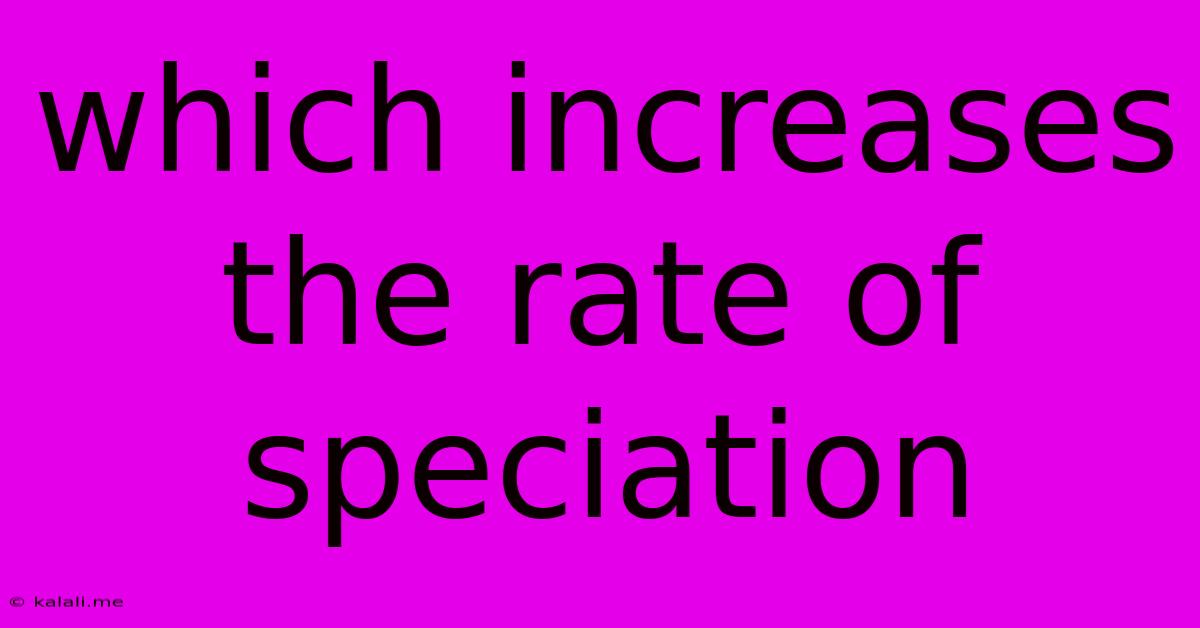Which Increases The Rate Of Speciation
Kalali
May 10, 2025 · 3 min read

Table of Contents
Factors that Increase the Rate of Speciation
Meta Description: Discover the key factors driving rapid speciation, from geographic isolation and sexual selection to adaptive radiation and polyploidy. Learn how these mechanisms contribute to the incredible biodiversity on Earth.
Speciation, the process by which new biological species arise, is a fundamental process in evolution. Understanding what accelerates this process is crucial to comprehending the vast biodiversity we see on Earth. While the exact rate varies significantly depending on the organism and its environment, several factors are known to significantly increase the rate of speciation. This article explores those key influences.
1. Geographic Isolation (Allopatric Speciation)
Perhaps the most well-understood mechanism driving speciation is geographic isolation. When a population is physically separated into two or more groups, gene flow between them ceases. Over time, these isolated populations accumulate genetic differences due to various factors such as:
- Genetic drift: Random changes in gene frequencies, particularly pronounced in smaller, isolated populations.
- Natural selection: Different environmental pressures in the separate locations favor different traits, leading to divergent evolution.
- Mutations: New genetic variations arise independently in each population.
The longer the isolation persists, the greater the genetic divergence, eventually leading to reproductive isolation – the inability of individuals from the different populations to interbreed successfully. This marks the completion of speciation. Examples include Darwin's finches in the Galapagos Islands and the various species of squirrels separated by the Grand Canyon.
2. Sexual Selection
Sexual selection, where individuals with certain traits are more successful at attracting mates, can significantly accelerate speciation. This is particularly true when sexual selection favors different traits in different parts of a population's range. For example, if females in one area prefer brightly colored males, while females in another area prefer males with elaborate songs, this can lead to the rapid divergence of mating signals and eventually reproductive isolation. This process can even occur within a single geographic area, a phenomenon known as sympatric speciation.
3. Polyploidy
Polyploidy, the presence of more than two sets of chromosomes, is a common mechanism of speciation, particularly in plants. A polyploid individual is reproductively isolated from its diploid ancestors because it cannot successfully mate with them. Polyploidy can occur through various mechanisms, including chromosome duplication within a single species (autopolyploidy) or the hybridization of two different species followed by chromosome doubling (allopolyploidy). This process can lead to rapid speciation because a new species is effectively created instantly.
4. Adaptive Radiation
Adaptive radiation describes the rapid diversification of a lineage into a variety of ecological niches. This often occurs following colonization of a new environment with few competitors or after a major evolutionary innovation. The classic example is the diversification of Darwin's finches, which rapidly evolved different beak shapes and sizes to exploit various food sources on the Galapagos Islands. The availability of many unoccupied niches fuels rapid divergence and speciation.
5. Hybridization
While often seen as a barrier to speciation, hybridization can, under certain circumstances, accelerate it. When two species hybridize, the offspring may possess novel combinations of genes that confer advantages in certain environments. If these hybrids are reproductively isolated from their parent species, they can form a new species. This is particularly common in plants.
Conclusion
The rate of speciation is influenced by a complex interplay of factors. While geographic isolation provides a clear and often crucial starting point, sexual selection, polyploidy, adaptive radiation, and even hybridization can significantly increase the speed at which new species emerge. Understanding these mechanisms helps us appreciate the remarkable diversity of life on Earth and the ongoing processes that continue to shape it.
Latest Posts
Latest Posts
-
10 Out Of 16 In Percentage
May 10, 2025
-
Cuanto Es 1 Kilometro En Millas
May 10, 2025
-
What Is 126 Inches In Feet
May 10, 2025
-
What Percentage Is 27 Out Of 40
May 10, 2025
-
21 Out Of 30 Is What Percent
May 10, 2025
Related Post
Thank you for visiting our website which covers about Which Increases The Rate Of Speciation . We hope the information provided has been useful to you. Feel free to contact us if you have any questions or need further assistance. See you next time and don't miss to bookmark.